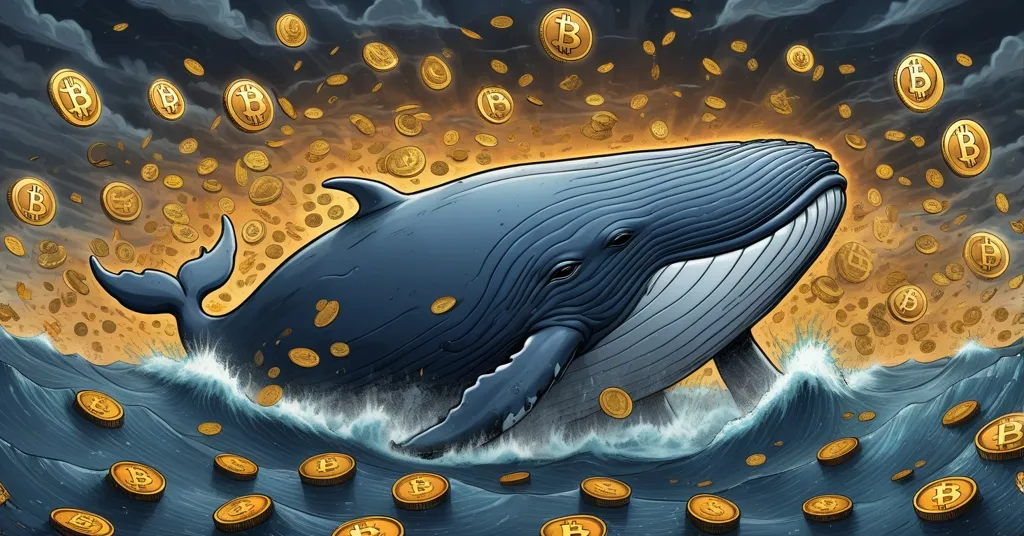Bitcoin OG Whales Dump Record BTC in 2025: Market Chaos or Evolution?

Bitcoin OG Whales Sell Record BTC in 2025: Market Impact Unpacked
Bitcoin’s earliest investors, known as OG whales, have made headlines in 2025 by offloading their holdings at a scale never witnessed in any previous market cycle. According to Charles Edwards of Capriole Investments, these long-term holders—those gripping their BTC for over seven years—are dumping coins in unprecedented volumes, sparking intense speculation about the implications for Bitcoin’s price and the broader crypto market. With Bitcoin recently swinging from a dip below $89,000 to a recovery around $91,800, the actions of these veterans are a focal point for enthusiasts and investors alike.
- Historic Selling Surge: OG whales have sold more Bitcoin in 2025 than in any past cycle.
- Constant Distribution: Selling remains high even in quiet periods, above 0.05% of Bitcoin’s market cap.
- Price Swings: BTC dropped under $89,000 recently but rebounded to approximately $91,800.
- Historical Warnings: Past heavy selling by long-term holders often signaled market tops.
- Market Questions: Unique 2025 dynamics raise doubts about whether old patterns will hold.
Who Are These OG Whales?
Before diving into the numbers, let’s break down who these OG whales actually are. In the Bitcoin realm, a “whale” refers to an individual or entity holding a significant amount of BTC—think thousands of coins, enough to move markets with a single transaction. The “OG” label, short for “original gangster,” applies specifically to those who’ve held their Bitcoin for over seven years without selling or transferring. These are the pioneers who mined or bought BTC when it was dirt cheap, often back in the early 2010s when a single coin was worth less than a pizza. They’ve endured every crash, every “Bitcoin is dead” headline, and every wave of fear, uncertainty, and doubt. Some might even be owners of forgotten wallets—digital stashes locked away due to lost private keys (think of these as combinations to a digital safe) that have only recently been rediscovered. Their sudden activity in 2025 is both fascinating and unnerving.
Record-Breaking Sales in 2025: The Data Speaks
Charles Edwards, founder of Capriole Investments, dropped a staggering insight about Bitcoin whale activity this year, noting the sheer volume of sales from these long-term holders. His analysis reveals a clear trend: 2025 has seen more selling from 7+ year holders than any other cycle in Bitcoin’s history, as detailed in a recent report on Bitcoin OG whale activity. Looking at the data, we observe sharp, consistent spikes in spending from these accounts throughout the year, with one spike in particular towering over others in terms of raw scale. To put this into perspective, even during calmer market periods, the baseline of selling hasn’t dropped below 0.05% of Bitcoin’s total market cap—a threshold that translates to millions of dollars in daily transactions hitting exchanges. Compared to past cycles like 2017 or 2021, where selling from old hands was notable but sporadic, this year’s persistent distribution is a whole new beast. It’s not just a blip; it’s a sustained wave, and it’s got everyone paying attention.
Why Are OG Whales Selling Now?
So, why the sudden rush to the exits after years of unwavering commitment? Let’s dissect the leading theories.
Profit-Taking in a Bull Run: The most straightforward explanation is cold, hard cash. Bitcoin’s price in 2025 has been a rollercoaster, flirting with six-figure territory before dipping below $89,000 mid-week and clawing back to around $91,800. If you snagged BTC at $1 or even $100 a decade ago, seeing these numbers might feel like hitting the jackpot—time to trade digital gold for a yacht or a mansion. Bull runs, even choppy ones, often tempt even the most resolute holders to lock in life-altering gains.
Bitcoin’s Aging Supply: Another factor is the natural maturation of Bitcoin’s circulating coins. Launched in 2009, Bitcoin is now over 15 years old, meaning a growing chunk of its supply—currently around 19.5 million mined coins out of a 21 million cap—falls into the “ancient” category of 7+ years. Simply put, as time marches on, more Bitcoin qualifies as long-held, so statistically, we’d expect a larger pool of coins to be eligible for selling. This structural shift could partly explain the higher distribution levels we’re seeing in 2025 compared to earlier cycles.
Lost Wallets Resurfacing: Then there’s the wild card—forgotten stashes coming back online. Bitcoin’s decentralized setup means if you lose your private key, your funds are inaccessible until that key is found. Over the years, tales of misplaced hard drives or scribbled seed phrases unlocking millions in BTC have surfaced. Could some of 2025’s selling be from a miner from 2011 stumbling upon a dusty USB drive? It’s a tantalizing possibility, though we lack hard data to confirm how much of this sell-off ties to rediscovered treasure.
Market Impact: Volatility and Bitcoin Price in 2025
Speaking of Bitcoin’s price, the volatility in 2025 has been enough to give even seasoned investors whiplash. A recent drop below $89,000 sent shockwaves through the community, particularly among newer entrants unaccustomed to BTC’s wild swings. The recovery to roughly $91,800 offers some relief, but it’s hardly a green light for complacency. Could this wave of OG whale selling be fueling the downward pressure? It’s plausible. When massive volumes of Bitcoin hit the market, it can spook retail investors, triggering panic sales and amplifying volatility. On the flip side, let’s not jump to conclusions—correlation doesn’t mean causation. Broader economic headwinds, like interest rate hikes or geopolitical tensions, could just as easily be the culprits behind these price dips. Anyone claiming to pinpoint the “real” driver of Bitcoin’s movements is likely peddling hot air. The truth is, markets are messy, and whale selling is just one piece of a chaotic puzzle.
Historical Patterns vs. New Realities
Historically, heavy selling from long-term holders has been a glaring red flag for Bitcoin reaching a market peak. In cycles like 2017 and 2021, when OG whales started dumping en masse, it often signaled the top was in, followed by brutal corrections that left latecomers holding the bag. These veterans seemed to have a sixth sense for when the party was over. But here’s the rub: 2025 isn’t playing by the old playbook. The crypto market has evolved, with institutional players, Bitcoin ETFs, and corporate treasuries like MicroStrategy’s massive holdings acting as potential buffers. If a whale sells 10,000 BTC, a BlackRock or Fidelity fund might scoop it up without blinking, stabilizing the market in ways retail-driven cycles of the past couldn’t. Add to that the broader adoption of Bitcoin as a store of value, and the old “whale sell, market crash” narrative might not hold water. Or it might. The jury’s still out on whether this is a false alarm or the prelude to pain.
The Double-Edged Sword of Decentralization
This wave of OG whale selling is a raw reminder of why decentralization matters. These investors aren’t answering to banks, governments, or any authority. They’ve held their private keys—their power—for years, and now they’re exercising their right to sell on their own terms. That’s the beauty of Bitcoin: pure, unadulterated freedom. It’s why we push for disruption and effective accelerationism, championing tech that upends the status quo at lightning speed. But let’s not kid ourselves—freedom cuts both ways. Mass selling can rattle markets, erode confidence, and leave newer players burned if a crash follows. Bitcoin isn’t a sanitized utopia; it’s a rugged, experimental frontier, and the actions of these whales in 2025 underscore just how unpredictable it can be. Privacy and autonomy come with responsibility, and sometimes, with collateral damage.
Broader Implications for Crypto Markets
Zooming out, the ripple effects of this selling spree extend beyond Bitcoin. If BTC faces a correction, could altcoins like Ethereum or Solana benefit as investors seek hedges? Ethereum’s role in decentralized finance (DeFi) and smart contracts offers stability in use cases Bitcoin doesn’t touch, while Solana’s speed might attract speculative capital fleeing volatility. I’m a Bitcoin maximalist at heart, believing it’s the ultimate future of money, but I’ll give credit where it’s due—other blockchains fill niches BTC isn’t designed for. Meanwhile, there’s a darker angle: regulatory scrutiny. Mass selling could catch the eye of governments, especially in jurisdictions itching to clamp down on crypto with tax grabs or capital gains crackdowns. And let’s not forget the psychological toll on retail investors—FOMO and panic-selling often spike when whale activity hits the news, fueled by social media buzz. Oh, and a quick word of caution: beware of shills exploiting this data to pump garbage tokens. Stick to fundamentals, not hype.
Key Questions and Takeaways on Bitcoin Whale Selling in 2025
- Why are Bitcoin OG whales selling at record levels in 2025?
Likely a mix of profit-taking during high prices, Bitcoin’s aging supply creating a larger pool of old coins, and possibly rediscovered lost wallets hitting the market. - Does this selling signal a Bitcoin market top?
Historically, heavy whale distribution marked peaks, but 2025’s institutional involvement and ETFs may disrupt old patterns, making outcomes uncertain. - How does whale selling affect Bitcoin price volatility?
Large sales can add downward pressure and spook retail investors, as seen with the dip below $89,000, though macro factors may play a bigger role. - Should new Bitcoin investors worry about OG whale behavior?
It’s worth watching, as mass exits can shake sentiment, but avoid knee-jerk reactions—focus on Bitcoin’s long-term value and fundamentals. - What does this reveal about Bitcoin’s evolution as an asset?
It shows Bitcoin’s maturity, with shifting holder dynamics reflecting both growing pains and the strength of decentralized, permissionless control.
As 2025 unfolds, Bitcoin’s journey remains a high-stakes thriller, with OG whales casting themselves as unpredictable protagonists. Whether their selling spree foreshadows a downturn or merely marks the natural evolution of an aging asset, one thing is undeniable: the crypto market thrives on chaos and reinvention. For every bullish surge teasing $100,000 dreams, there’s a bearish undertow waiting to strike. As a staunch believer in Bitcoin’s potential to redefine finance, I can’t help but poke holes in the panic—are we overblowing these sales, or are altcoins better poised to weather such storms with their varied applications? Perhaps. Yet Bitcoin’s resilience, forged through years of tumult, keeps us betting on disruption over complacency. Keep your wits sharp and your keys secure—this plot twist is just getting started.



